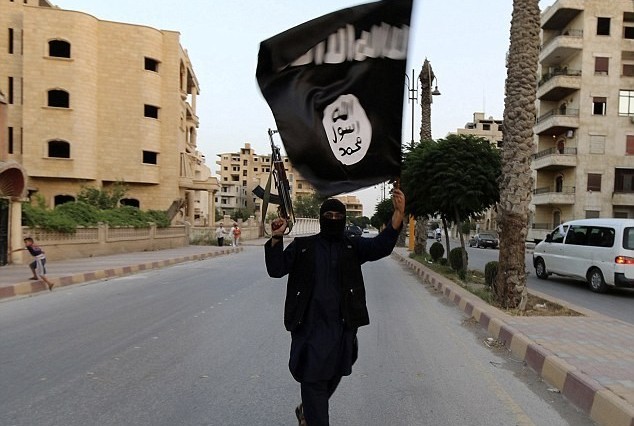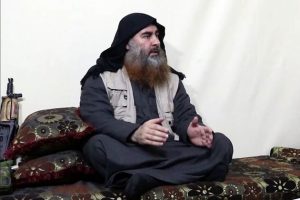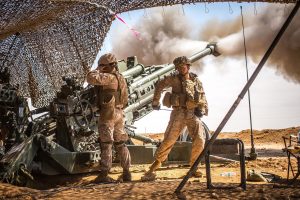by Wayne White
American political and media commentary on ISIS (which calls itself the Islamic State) since the beheading of James Foley has been flush with exaggeration and skewed focus. Identifying Foley’s murderer is desirable but far less important than tackling ISIS proper and its leadership. Unfortunately, many ISIS cadres have done far worse off camera. The voice narrating the video of Foley’s execution was British, and he was probably chosen by ISIS leader Abu Bakr al-Baghdadi simply to produce maximum shock effect in the West.
Most importantly, ISIS faces numerous challenges in holding onto what it has now, particularly in Iraq, where further expansion will likely be marginal. There are also ISIS vulnerabilities to be exploited by a new Iraqi government with much broader appeal. ISIS clearly poses a threat to the US (and other countries), but that threat needs to be soberly assessed.
Dialing Down the Hysteria
The beheading of Foley, a dreadful and tragic event, sparked a surge of gloom, doom, and hype among senior US officials and within the media at large. Of late, estimates of total ISIS fighters and foreign recruits have soared, but are based on what could only be iffy information. This is precisely what ISIS’s leaders intended.
ISIS perceives, as do other ruthless entities, that the US (and its allies) are traumatized far more by the death of one citizen than vastly broader atrocities in the Middle East. Hurt by US airstrikes (and fearing more) ISIS hoped to frighten Americans enough to make Washington back off. In that sense, the execution boomeranged: US and Western leaders are more alarmed, but determined to ramp up, not relax, measures against the radical Sunni group.
ISIS is dangerous, but its nature and the threat it represents must be defined accurately. A bizarre characterization of ISIS was made by Joint Chiefs Chairman General Martin Dempsey last week when he said ISIS has an “apocalyptic, end of days strategic vision.” This concept relates more closely to the Biblical New Testament Book of Revelation, reflecting mostly Christian, not Islamic, thinking. In fact, ISIS’s strategic vision, in historical terms, is rather pedestrian, albeit infused with barbarism: a quest to establish its version of a state, reinforce its power, defend or expand its present conquests, and lash out at its enemies.
Territorially, ISIS is weaker than suggested by the lurid maps showcased regularly by the media. Over 90% of the land under ISIS control is the driest, most underpopulated, and poorest in the greater Fertile Crescent region. In that respect, some of its holdings in Iraq are its most valuable assets, including large intact cities along rivers.
Vulnerabilities
The militant al-Nusra Front (less abusive than ISIS, and clashing with it in Syria) is well aware of ISIS’s vulnerability to foreign military action. It is no coincidence that al-Nusra released American hostage Peter Theo Curtis only days after Foley’s murder. Al-Nusra evidently is afraid of a harsh US response against ISIS, and hopes to keep out of the line of fire.
Despite the extent of its success, ISIS does not have a very large army of dedicated fighters. Its fanaticism and its use of shock, awe, and terror have been force multipliers. However, spread thin along the edges of its sprawling realm, it recognizes increased American aerial attacks in support of better-equipped Kurdish and revitalized Iraqi Army units could threaten areas far beyond just the Mosul Dam.
The heavy weapons ISIS secured while seizing Mosul and has since used to its advantage are largely irreplaceable, and continuing US air attacks would erode that edge quite a lot. At some point, ISIS could be reduced to fighting much as it did before—as light infantry.
Furthermore, having generated a more intense foreign and Iraqi domestic reaction, if faced with stiffer opposition simultaneously in both Syria and Iraq, ISIS would have to juggle its limited forces among various threatened sectors (always dicey). ISIS has also been fighting behind its own lines against surrounded Iraqi garrisons in one city, a major dam, Iraq’s largest refinery, several towns, and some areas dominated by hostile Sunni Arab tribes.
Many non-extremist ISIS Iraqi allies are potentially unreliable. However, ISIS does not have enough core combatants to fully occupy its vast holdings, so it depends heavily upon these allies.
As with its al-Qaeda in Iraq (AQI) predecessor, the restrictions and abuses committed by ISIS will eventually alienate many localities, secular Sunni Arab factions, and tribes. To keep tribes, Ba’athists, and former insurgents who do not share its fanatical vision loyal, ISIS might have to spread around some of its money.
Yet, in the face of airstrikes and warnings of worse from the Jordanians, Saudis and others close to former Sunni Arab Iraqi military officers and certain tribes, these fellow travelers could get very nervous about their future with ISIS. And with their prior nemesis in Baghdad, Nouri al-Maliki, gone, cutting a deal with a new government while decent terms can still be achieved could begin to look very inviting.
A New and Improved Iraqi Government?
To encourage the desertion of ISIS’s allies, prime minister-designate Haider al-Abadi must put together a new government tailored to—despite Baghdad’s political snake pit—reduce the Sunni Arab grievances upon which ISIS thrives. Grand Ayatollah Ali al-Sistani, a source of emulation for nearly all Iraqi Shi’a, knows this.
He appealed at prayers on Aug. 22 for a government made up of leaders who care about Iraq’s “future and its citizens,” regardless of their ethnic and religious affiliations, in a “realistic” fashion. Sistani’s pressure on Iraq’s dominant Shi’a majority politicians already made the difference in ousting Maliki. Hopefully, Sistani will keep the heat on until such a government is formed.
If many of ISIS’s allies are not wooed away, even a considerably revitalized Iraqi Army and Peshmerga supported by airstrikes might make only slow, costly progress against ISIS forces. In cities like Mosul, Fallujah, Ramadi, and others, ISIS could be near impossible to oust short of inflicting severe damage on these large urban areas. This is what happened across Syria in fighting between the regime and various rebels.
In 2004, from my perch in the US Intelligence Community, I warned of the destruction that would result from an American assault on insurgent-dominated Fallujah. Sure enough, despite the employment of crack US forces on the ground and far more careful use of firepower than by the Assad regime in Syria, the US operation heavily damaged the majority of the city. Some of the residual bitterness over that carnage still fuels militancy there—ISIS’s first unchallengeable conquest in Iraq.
Overseas Threat
Ironically, the danger of ISIS attacks radiating outward from its Syrian-Iraqi base would become more significant if ISIS suffered major reverses in the field. If the self-declared “Caliphate” was in retreat and its area of control shrinking, recruits flush with rage and possessing foreign passports would be more likely to leave intent on revenge.
There is, however, a more proximate threat. With numerous individuals inspired by ISIS’s twisted attitudes probably still at home, terrorist attacks could occur even if Western passport holders fighting with ISIS never return. Some of these domestic “sleepers” could attack soft targets at any time in response to calls from ISIS leader Abu Bakr al-Baghdadi—or as individuals.
So is ISIS a direct threat to the US? Yes. However, the same can be said of a number of al-Qaeda-affiliated groups. Instead of obsessing over that definition or chasing down one killer, all concerned must focus on how that overarching threat could manifest itself both domestically and regionally.





ISIS has an “apocalyptic, end of days strategic vision.”
I’d like to know more about the “apocalyptic vision” of the Zionist movement. Aren’t they supposed to believe when all Jews return to Israel, their biblical homeland, their messiah is going to appear and everything will be fine. The rest of the world, not so much. It’ll be fire and brimstone with a few nuclear wars on the side.
Compared to this “end-of-world” scenario, the ISIS apocalyptic vision” is probably quite sunny and optimistic. But I’m no expert.
Unfortunately, since Chechnya, the Russians have been correxct about Islam. The Frenchand British destroyed Ghadafi and the result is an islamist leaning failed state, the Europeans supported those who became ISIS against the guarantor of order in Syria, Assad. And the destructio of the Arab nationalist in the mould of Nasser in Iraq – Saddam Hussein, has now allowed, the theocratisation of the region, in response to the crack-brained idiocy of introducing one-man-one-vote t Iraq, thus inverting the thousand year old relationship between Shia and Sunni, in practice a metaphor for the Arab persian confrontation.
We and our leaders seem to be ignorant credulous idiots.
Now Turkey is theocratising as a Sunni state under a presiden twh is throwing off the inheritance of Attaturk.
The brutal truth about ISIS is that we can do nothing agaisnt their eventual; emergence as the Sunni power in that part of the crescent.
We should stop digging.
And we should dupport Assad. And accept the Russians as being quite correc in this one matter
The author wrote in part: “ISIS is dangerous, but its nature and the threat it represents must be defined accurately. A bizarre characterization of ISIS was made by Joint Chiefs Chairman General Martin Dempsey last week when he said ISIS has an “apocalyptic, end of days strategic vision.” This concept relates more closely to the Biblical New Testament Book of Revelation, reflecting mostly Christian, not Islamic, thinking.”
This is simply not true.The Quran has some End of Days description (see the 75th Sura) but there is also the Hadith which contain much more. I would expect an “intelligence briefer to senior officials” to be aware of Article 7 in the HAMAS Covenant which concludes with this: “The Day of Judgement will not come about until Moslems fight the Jews (killing the Jews), when the Jew will hide behind stones and trees. The stones and trees will say O Moslems, O Abdulla, there is a Jew behind me, come and kill him. Only the Gharkad tree, (evidently a certain kind of tree) would not do that because it is one of the trees of the Jews.” (related by al-Bukhari and Moslem).”
ISIS grew out of al Qaeda in Iraq and although they were a breakaway group they were still influenced by Ussama bin Laden. Bin Laden took many aspects of Shia eschatology and grafted them onto his vision. I’m not a fan of General Dempsey but he was correct in his description and Wayne White is just plain wrong.
@Bear Hamas Charter, which you are not accurately quoting from, has nothing to do with the Quran, even if they are Muslim. Educate yourself.
Karen, not only are you wrong about the HAMAS charter but you misread what I wrote. First, I did a copy and paste from the Yale Law School web site known as the Avalon Project. The same quote can be found in many other places as well. It is accurate. Second, I never stated the quote was from the Quran. I attributed it as being a Hadith. Here are some links for you. Go educate yourself: